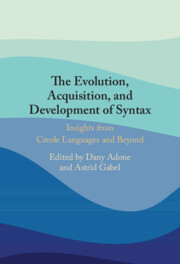Refine search
Actions for selected content:
3 results

The Evolution, Acquisition and Development of Syntax
- Insights from Creole Languages and Beyond
-
- Published online:
- 19 February 2025
- Print publication:
- 06 February 2025
3 - Pidgins and Creoles
-
- Book:
- Linguistic Contact and Language Change
- Published online:
- 22 December 2024
- Print publication:
- 05 December 2024, pp 55-105
-
- Chapter
- Export citation
22 - Language and the media
- from Part V - Applied sociolinguistics
-
-
- Book:
- The Cambridge Handbook of Sociolinguistics
- Published online:
- 05 June 2012
- Print publication:
- 06 October 2011, pp 396-412
-
- Chapter
- Export citation
